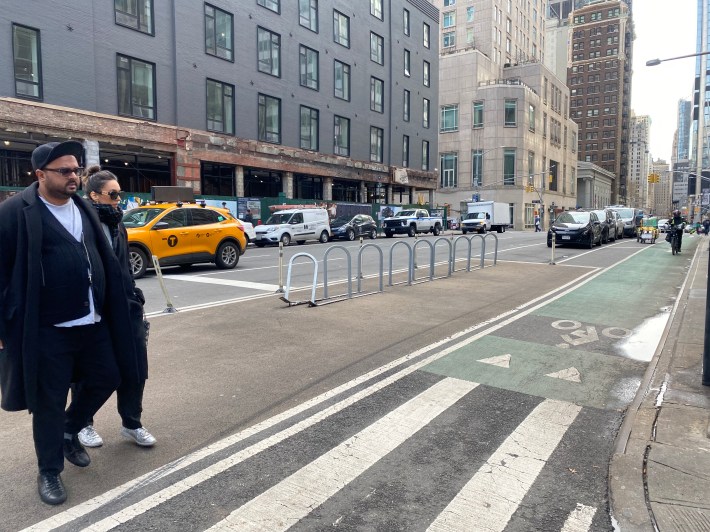It's a concrete solution.
Mayor Adams's announcement last week that he intended to eliminate parking spaces near 1,000 intersections a year to improve visibility and reduce crashes will fail unless his administration backs up the initiative with physical barriers to keep out cars, advocates and our own damn eyes say.
“Driver’s know there’s almost no parking enforcement and they act accordingly,” said Bike New York Advocacy Director Jon Orcutt, who used to work at DOT under the Bloomberg administration. “If it’s just paint in 2023, forget about it.”
Even flimsy, $40 per pole plastic sticks can be a (sometimes) useful improvement over just paint, as Hoboken has shown. In that New Jersey city, officials have aggressively removed parking from intersections — and there hasn't been a traffic death since 2017.
It's unclear how many of New York's 1,000 intersections per year will be daylighted with physical infrastructure, and the agency's press office declined to give an estimate.

DOT also didn't specify how much money it plans to invest in daylighting, but spokesman Vin Barone said the agency with a $1.4 billion annual budget will do the majority of daylighting in-house.
Early in his tenure, Mayor Adams boasted that he would give DOT $904 million more to invest in street safety over five years, but there have been scant details on where that funding has gone ever since.
The city has said it has made hundreds of intersections safer, but the numbers show that most crossings were improved by merely adjusting walk signals to give pedestrians more time to cross the street or by adding more stop signs. Orcutt worried that Hizzoner was going to proceed similarly with his daylighting efforts.
"If you’re basically just trying to get headlines or a press release with a four-digit number, the odds are a lot of it’s going to be ineffective," he said.
State law already bans parking within 20 feet of crosswalks, but the city has long exempted itself from that rule in favor of more private car storage close to its roughly 47,000 intersections across the five boroughs.
DOT Commissioner Ydanis Rodriguez has argued that the street safety design was “not the right solution everywhere," telling the City Council during an oversight hearing in April that daylighting “must be implemented with physical infrastructure in the newly opened space to prevent vehicles from turning more quickly.”
Rodriguez is right; we were able to easily find existing daylighting that didn't work because motorists ignored painted markings and parking regulations at corners:
One doesn’t have to search far to find bad actors in areas like in Downtown Brooklyn and Lower Manhattan, which are havens for awful parking due to the large number of government employees using parking placards to dump their cars wherever they want, as Streetsblog reported in last year's placard census.
Without any physical protection, spaces designated for pedestrians just become a free-for-all for illegal parking, such as this NYPD van blocking a pedestrian island on Jay Street outside Brooklyn's Supreme Court:

Outside the headquarters of the Metropolitan Transportation Authority at the southern tip of Broadway, a city-owned vehicle sporting a police placard in the dash was parked in a painted sidewalk extension, blocking the view of any oncoming traffic for pedestrians.
That municipal vehicle was also caught breaking a red light in Brooklyn just a few weeks ago:

Several intersections with daylighting currently rely on "No Standing" or "Loading Zone" signs, but without any enforcement by the cops, drivers just gobble up those spots.
Outside this post office on Church Street near the World Trade Center campus drivers were double-parked in a "No Standing" zone. Both drivers closest to the intersection have a history of illegal parking in the area, however, it seems they've been getting off scot free in more recent years.

Near the Brooklyn Bridge's Manhattan end on Spruce Street, a school bus parked in a "No Standing" zone endangered pedestrians, including students trying to get to Pace University across the street.

Back in Brooklyn, a pair of Verizon vans also ignored a "No Standing" sign on Ashland Place, blocking sight lines almost entirely.

Daylighting starts to work a little better when DOT deploys more prominent street markings, like its beige gravel paint that aims to carve out pedestrian spaces like curb extensions and pedestrian islands.
The islands do stay clear where officials installed more effective blockades, like bike racks, boulders, and planters, something the agency has also done to successfully daylight corners on the Berry Street bike boulevard in Brooklyn, or the recently opened bike paths in Long Island City (though the damage to this bike rack shows drivers don't even respect physical barriers):

Some of those light-brown carve-outs also have plastic flex posts to discourage drivers, but motorists can easily mow past the flappers if there’s nothing else to keep them out, as was the case here along the Church Street bike lanes in Tribeca.

And then it just becomes more free parking.

If Adams is serious about daylighting, he should give DOT the resources to follow up paint with proper protections, said Orcutt.
"We should have a big construction program that comes behind all of the paint that DOT installs, and no one has gotten behind that and it’s not going to get better in the city until we do do that," he said.






